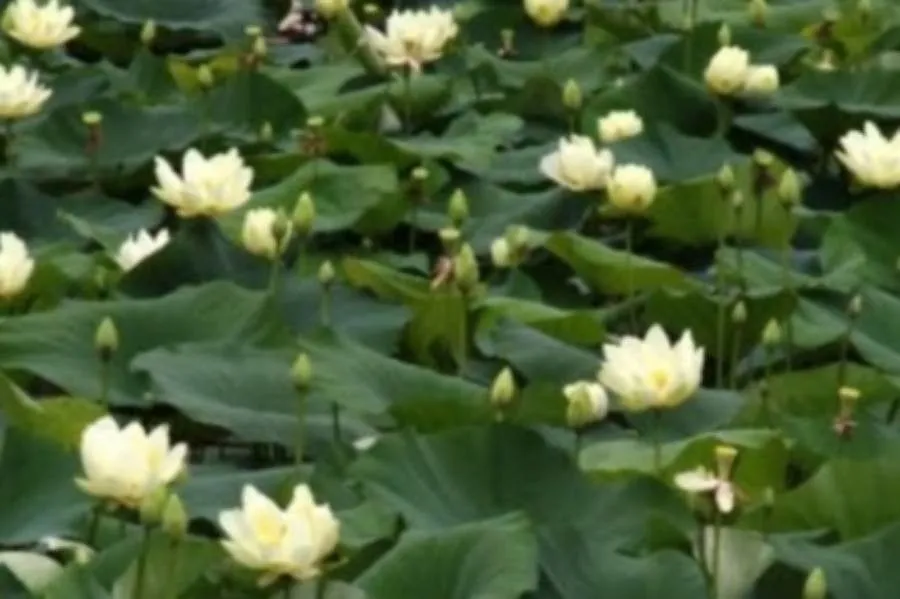
Author: (Willd.) Pers.
Bibliography: Syn. Pl. 2: 92 (1806)
Year: 1806
Status: accepted
Rank: species
Genus: Nelumbo
Vegetable: False
Observations: SE. Canada to Mexico, Greater Antilles, Colombia
Introduction
Volée, scientifically known as Nelumbo lutea, is a captivating aquatic plant that has garnered interest due to its striking appearance and ecological significance. This perennial species belongs to the family Nelumbonaceae and thrives in a variety of wetland habitats. Notably, it is known for its sizeable, elegant flowers and distinctive foliage which make it a prominent feature in the ecosystems it inhabits.
Geographical Distribution
Volée has a wide geographical distribution reaching from southeastern Canada extending through the United States, and down to Mexico. It is also found in the Greater Antilles and has been recorded in Colombia. This widespread presence underscores the plant’s adaptability to a range of climatic conditions, primarily in wetland and aquatic environments.
Morphological Characteristics
The plant is characterized by its large, peltate leaves that float on water surfaces, providing a lush, green cover. The leaves are typically orbicular and exhibit a water-repellent surface, which is a notable feature of this species. It produces striking yellow to creamy-white flowers that rise above the water, attracting various pollinators. These blooms are not just beautiful but also considerably large, making them easily noticeable in their natural habitat.
Ecological Significance
Volée plays a crucial role in its ecosystem. Its floating leaves provide habitat and breeding grounds for various aquatic fauna, including insects and amphibians. The plant’s roots and stems offer shelter and food for fish and other aquatic organisms. Furthermore, it contributes to the stability of wetland environments by preventing soil erosion and filtering water, thus maintaining water quality.
Cultural Importance
This species also holds cultural significance in the regions where it is found. Historically, the indigenous peoples of North America utilized various parts of the plant for food and medicinal purposes. The seeds and tubers were particularly valued as a nutritious food source.
Conservation Status
While Nelumbo lutea is not currently listed as endangered, its habitats are increasingly threatened by human activity, including pollution, development, and climate change. Conservation efforts are vital to protect the natural wetlands that are crucial for the survival and proliferation of this species.
Conclusion
Nelumbo lutea, or Volée, is more than just an ornamental aquatic plant. It is an integral part of the wetland ecosystems across its wide range, providing ecological benefits and holding cultural significance for many communities. Understanding and preserving this remarkable plant is essential for maintaining the health and diversity of the habitats it supports.
Eng: american lotus, american nelumbo, water chinquapin, yellow lotus
Fra: lotus jaune d’amérique, nélumbo, volée
En: Volée, Water-chinquapin, American Lotus, LOTUS, American nelumbo, Water chinquapin, Yellow lotus
Ar: نيلم أصفر
Bg: Жълт лотос
Zh: 美洲黄莲
Hr: Američki lotos
Fi: Amerikanlootus
Fr: Lotus jaune d’Amérique, Nélumbo, Volée
De: Amerikanische Lotosblume
He: נלומבו צהוב
Lt: Geltonasis lotosas
Ml: നെലംബോ ലൂട്ടിയ
Mr: अमेरिकन कमळ
No: Amerikansk lotus
Fa: نلومبو لوتئا
Ru: Лотос жёлтый
Sv: Amerikansk lotus
Vi: Sen trắng
: American lotus
Taken Aug 20, 2019 by that’s someguy (cc-by-sa)
Taken Jul 16, 2022 by Sylvain Dubief (cc-by-sa)
© copyright of the Board of Trustees of the Royal Botanic Gardens, Kew.
© copyright of the Board of Trustees of the Royal Botanic Gardens, Kew.
© copyright of the Board of Trustees of the Royal Botanic Gardens, Kew.
Growth form>: Rhizomatous
Growth habit>: Forb/herb
Growth rate>: Moderate
Ph maximum: 8.7
Ph minimum: 4.6
Family: Myrtaceae Author: (F.Muell.) K.D.Hill & L.A.S.Johnson Bibliography: Telopea 6: 402 (1995) Year: 1995 Status:…
Family: Rubiaceae Author: Pierre ex A.Froehner Bibliography: Notizbl. Bot. Gart. Berlin-Dahlem 1: 237 (1897) Year:…
Family: Sapindaceae Author: Koidz. Bibliography: J. Coll. Sci. Imp. Univ. Tokyo 32(1): 38 (1911) Year:…
Family: Asteraceae Author: A.Gray Bibliography: Pacif. Railr. Rep.: 107 (1857) Year: 1857 Status: accepted Rank:…
Family: Fabaceae Author: Medik. Bibliography: Vorles. Churpfälz. Phys.-Ökon. Ges. 2: 398 (1787) Year: 1787 Status:…
Family: Aspleniaceae Author: (Cav.) Alston Bibliography: Bull. Misc. Inform. Kew 1932: 309 (1932) Year: 1932…